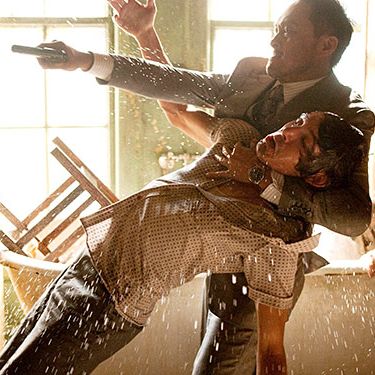
We’ll be the first ones to admit that we went a little Inception crazy this summer, what with our interviews and our crackpot theories and our Oscar prognostications and our bathroom-break guides. So did you really think we’d be able to resist taking an early look at the Inception Blu-ray/DVD set, which hits shelves next week, to see what new tidbits we’d be able to discover about the film? In keeping with what appears to be recent Christopher Nolan policy, the Blu-ray doesn’t come with any commentary, but it does come with an extra disc of features, as well as some fascinating mini-featurettes (accessible while watching the film) about the thinking that went into many pivotal scenes. We’ve now gone through them, and here’s what we can report …
Christopher Nolan might have said Inception’s dreams aren’t a metaphor for filmmaking, but the extras on his Blu-ray suggest otherwise.
Nolan recently did an interview with Wired in which he knocked down numerous Inception theories, including those that posit that the film’s portrayal of dreams is supposed to correlate to the filmmaking process. But in a pretty interesting documentary about the logic of dreams included on the Blu-ray, called Dreams: Cinema of the Subconscious and presented by Joseph Gordon-Levitt, there is actually quite a bit of material about … how dreams are a lot like filmmaking. To be fair, Nolan didn’t direct or even produce the documentary, but he did allow it to be included on the Blu-ray. So either he’s more amenable to this interpretation than one might infer from the Wired interview, or he just didn’t watch the documentary.
You shouldn’t feel too bad if you were convinced Cobb’s kids were wearing the same clothes at the end.
Both Nolan and his costume designer have confirmed resoundingly that Cobb’s kids are wearing different clothes at the end of the film (and, more important, that they are, in fact, older), and we ourselves could never quite understand why some people were convinced the kids were wearing the same clothes. But now that we’ve been able to put these shots side by side, we have to say: While the kids are in fact wearing different clothes (and, most definitely, different shoes), somebody (ahem) clearly wanted to keep things a bit uncertain.
Limbo ain’t just a town in Morocco, but at least some of it is …
This information was presumably out there during the film’s release and production, but it’s pretty fascinating nonetheless: During one of the mini-production-featurettes on the Blu-ray, Nolan notes that much of the Limbo scenes were apparently shot (with some digital gussying-up, of course) in some wasteland-ish apartment complexes “in the middle of nowhere” in Morocco that the production discovered as they were driving from the airport while location scouting in Tangiers (the town where they shot the Mombassa sequences). Somebody tell the Moroccan Tourism Board!
All that water imagery might be more important than previously thought.
In some supplementary material on how they conceived of and created the Limbo sequences, Nolan discusses the importance of water in Limbo, about how it “represents the subconscious that is over time eating away at this vision” that Mal and Cobb have created. That’s an interesting and poetic thought in and of itself, but it also gets us thinking about the fact that Inception actually begins with close-ups of water and waves, almost as if the film itself were a vision that’s being eaten away by the subconscious. But wait … that would mean … Nah, let’s not go there.
That Saito is one devious dude.
In a fifteen-minute motion comic called Inception: The Cobol Job included on the disc (it was also available as a straight comic around the time of the film’s release), we get a fun glimpse into the events that led to the film’s opening sequence of Cobb and Arthur trying to enter Saito’s mind. Basically, they were hired by Cobol Engineering (Saito’s rivals) to enter into the mind of Saito’s chief engineer, Kaneda, to extract some information about his company’s expansion plans. But only at the very end did they realize that Kaneda did not actually have access to these plans. Instead, Saito had them hidden away inside his own brain, and only he knew them. Now, what’s additionally interesting about the Cobol job is that Cobol is in cahoots with Fischer-Morrow, the company at the heart of the inception heist in the film proper. So apparently Saito somehow let it leak to his competitors that he was expanding and then devised an elaborate plan to get them to invade his dreams, all so he could audition Cobb and Co. for a job in which they’d then have to go back and invade his competitors’ dreams. Which all suggests that Saito had been planning on this “audition” for Cobb for quite some time.
Oh, and if you want to spend the rest of your day on Wikipedia …
… You may be interested to know that Saito’s company is called Proclus Global.


